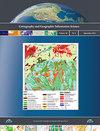Discovering spatiotemporal flow patterns: where the origin–destination map meets empirical orthogonal function decomposition
IF 2.4
3区 地球科学
Q1 GEOGRAPHY
Cartography and Geographic Information Science
Pub Date : 2023-02-21
DOI:10.1080/15230406.2023.2171490
引用次数: 1
Abstract
ABSTRACT Flows are usually represented as vector lines from origins to destinations and can reflect the movements of individuals or groups in space and time. Revealing and analyzing the spatiotemporal flow patterns are conducive to understanding information underlying movements. This paper proposes a new method called the OD – EOF (Origin – Destination – Empirical Orthogonal Function) to discover important spatiotemporal flow patterns on the premise of maintaining the pairwise connections between origins and destinations. We first construct a spatiotemporal flow matrix that contains connection information between origins and destinations and temporal flow information by adding a temporal dimension to the OD map. Then, we decompose the spatiotemporal flow matrix into spatial modes and corresponding time coefficients by EOF decomposition. The decomposition results depict the prominent spatial distribution of and temporal variation in flows, with most of the spatiotemporal characteristics highly concentrated into the first few spatial modes. The method is evaluated by five synthetic datasets and a user study and subsequently applied to analyze the impact of the COVID-19 pandemic on the spatiotemporal patterns of human mobility in China during the Spring Festival travel rush in 2020 and 2021. The results show the prominent spatiotemporal patterns of human mobility during these periods under the influence of the COVID-19 pandemic outbreak and the normalization of pandemic prevention and control.发现时空流动模式:起点-终点图满足经验正交函数分解
摘要流通常表示为从起点到终点的矢量线,可以反映个人或群体在空间和时间上的运动。揭示和分析时空流动模式有助于理解运动背后的信息。本文提出了一种新的方法,称为OD–EOF(起源-目的地-经验正交函数),以在保持起源和目的地之间的成对连接的前提下发现重要的时空流动模式。我们首先通过向OD图添加时间维度来构建时空流矩阵,该矩阵包含起点和终点之间的连接信息以及时间流信息。然后,我们通过EOF分解将时空流矩阵分解为空间模式和相应的时间系数。分解结果描述了流量的显著空间分布和时间变化,大多数时空特征高度集中在前几个空间模式中。该方法通过五个合成数据集和一项用户研究进行评估,随后应用于分析新冠肺炎疫情对2020年和2021年春运高峰期间中国人口流动时空模式的影响。研究结果表明,在新冠肺炎疫情暴发和疫情防控常态化的影响下,这些时期人类流动的时空格局突出。
本文章由计算机程序翻译,如有差异,请以英文原文为准。
求助全文
约1分钟内获得全文
求助全文
来源期刊
CiteScore
5.20
自引率
20.00%
发文量
23
期刊介绍:
Cartography and Geographic Information Science (CaGIS) is the official publication of the Cartography and Geographic Information Society (CaGIS), a member organization of the American Congress on Surveying and Mapping (ACSM). The Cartography and Geographic Information Society supports research, education, and practices that improve the understanding, creation, analysis, and use of maps and geographic information. The society serves as a forum for the exchange of original concepts, techniques, approaches, and experiences by those who design, implement, and use geospatial technologies through the publication of authoritative articles and international papers.

 求助内容:
求助内容: 应助结果提醒方式:
应助结果提醒方式:


